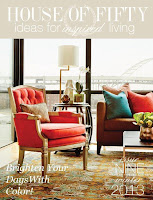In the past few years the popularity of designing kids rooms has grown immensely. It's good to see such an interest and really amazing spaces being created! I love that we seem to be thinking more about the spaces our children inhabit than we used to {compared to my childhood circa 1980's}. Yet, I can't help but wonder if some of the design elements we infuse into these kid-friendly spaces are perhaps not as much about what inspires them, but about how it looks in our home or what we think our kids would like. Is the room designed with kids
in mind or is it designed
for our kids? I do think we can have spaces that look beautiful and cohesive to our home, but we must give considerable weight to how our little ones react to the room as well.
When I think about how my five boys respond to design, I know it is usually based on how the space makes them feel. If you ask your child how they remember a big event, they often describe a detail or two, but overall they remember the feelings it evoked. While four out of five of my boys cannot yet describe their feelings beyond a few words, what I can get is their emotion, which is key. As a mom with an interest in design and how it affects us, I have realized that kids are so much more in tune with their surroundings than we give them credit for. While they may be resilient and adaptable, their curiosity thrives in spaces where they first feel safe and secure.
Inspiring the Magic and Wonder
More than enjoying a colorful or themed room, my boys would love a room that evokes a sense of magic and wonder, one that just
is special. I cannot think of a better time than now to use those as the primary design elements. How fun would this be?
"A little nonsense now and then is cherished by the wisest men" - Roald Dahl
I realize we all can't live with swings hanging from the rafters of our living rooms {sharing problems for starters}, but we can channel that whimsy into something that is extraordinary and unexpected like this little teepee nook {and is not permanent}.
House Beautiful, May 2011
All children love hidden spaces. I still recall my dentist's office having a playroom with a tiny hole to crawl through that opened into a bigger playroom. It was just
so cool, like this space, begging us to follow the little ladder.
If we do move our littlest guys into two separate rooms, we plan to connect the rooms through their closets. It would be so fun for them to have a
secret passage to get from room to room.
{BOYS}
Evoking that sense of wonder and whimsy with big doses of practicality, these bedrooms would definitely make an impression on a young boy...slide, tree house, who wouldn't love either?
{GIRLS}
I can think of all the dreams, stories, nighttime chats among sisters that would take place on these two gorgeous beds. I am sure these little red beds would be fondly remembered forever.
What little fairy princess would not adore this sweet little spot?
Sharing Spaces
We will always have this dilemma in our home. My quadruplet boys are in one room right now and there were many constraints at the time it was created. But I still wanted to reflect each one individually in the space.
Whether we keep the boys together, or move them into two separate rooms, these following ideas gave me some inspiration. I just love this first idea {left}, each child has a little cocoon with their favorite possessions, but they can easily get to one another. The girls room {right} is so easy, relaxed and such a fun space to hang out as sisters.
Learning through Play, Lessons from Good Design
Good design can teach kids about function, organization, and making choices. Playrooms are such a big source of inspiration for little ones. With our home's open floor plan, the playroom for our little boys is in plain sight. It does get tricky to keep it clean, but the space itself is so fun and inspiring. If you see toys in my home, you know I have small children who are learning and growing. Someday we hope to finish our basement and move the playroom there, but I truly believe my kids have benefited by having a playroom so centrally located in our home at this stage in their lives.
In our playroom they can make choices and there are many opportunities for being creative:
a felt board, dry erase board/easel, and chalkboard are all easily within reach along with
dress-up and so many other options. I also believe in everything needing to have a space in a playroom and cleaning up throughout the day. While kids need to be able to
be creative, it is difficult to function in chaos, so some sense of order needs to be re-established.
Gorgeous with so many different options, possibilities and well-organized!
This one just plays to the imagination so well...
...and this one is free-spirited and a fun-loving space.
And do you have Lego in your home? Here's a little inspiration for those of us literally driven up the wall by little Lego pieces!
Staying Inspired as Adults
When was the last time you read a children's book? They are full of inspiration and help us remember what it is to see the world in that wonder-filled way. We have an abundance of books in our home and treasure them! I will truly be sad when there are no longer bedtimes full of whimsical, fantastical stories. Lucky is the child whose room is full of great reads like this one.
I have realized that at the end of the day, we are still adults trying to create spaces for our children who tend to be much more open-minded, engaged in their surroundings and in
all of life than most of us adults. While we all have constraints, we can still create spaces, moments, and celebrations that are special.

Thank you Michelle for sharing such a thoughtful post on creating rooms for children! It reminded me of the moment it was time to work on Max's room and the first thing I did was sit down and interview him about his wishes, likes and dislikes for the room. Amazingly, looking back, the end result of this room wonderfully reflected him in a way it most certainly would not have had I not listened to him before beginning!
For read more, visit Michelle's blog here.













































































